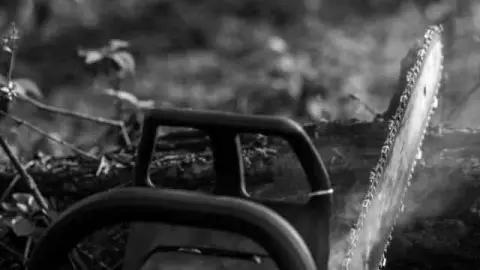A smoking chainsaw can be worrying whether you’ve just bought a new chainsaw or it starts smoking suddenly after months of trusty service. There are a few different problems with a chainsaw that can lead it to smoke when it’s started.
A chainsaw smoking on startup can result from overheating due to excessively tight chain bar tension, lack of oil, improper gas-oil ratios, or a clogged spark arrestor. Continuing to use a chainsaw while smoking can cause damage and eventually cause it to fail.
Seeing smoking when you operate your chainsaw is a sign that something’s wrong if it accompanies other operating issues, so don’t ignore it if you see it. Keep reading to learn more about the causes of chainsaw smoke and what you can do to fix it when it happens.
Why Does a Chainsaw Smoke on Startup?
Smoking in a chainsaw can be an issue that shows up the first time you run a chainsaw or it can set in later after use. This is because it can result from several different issues. Here are a few reasons why a chainsaw might smoke on startup regardless of how long you’ve had it (Source: Fixya):
- The chain/bar is overheating: A chainsaw chain/bar might overheat for several reasons, such as excess chain tension or airflow problems. If the operator continues to use the chainsaw while it is overheating, this can eventually cause the engine or pistons on the chainsaw to break.
- There’s a problem with the fuel in the chainsaw: Chainsaw fuel should typically be a 50:1 mix of fuel and oil to prevent the oil in the fuel from smoking. Check the user manual for your chainsaw to see what mixture of fuel should be used.
If a chainsaw begins to smoke on startup from the exhaust, the operator shouldn’t continue to use it if the smoke doesn’t clear in a few moments. Instead, the chainsaw should be shut off completely and examined to determine the source of the smoke and troubleshoot its cause.
When a Chainsaw Smokes and Shuts Off
Chainsaws can smoke for a few different reasons, but there are some specific points you can start looking at if you also get the symptom of your chainsaw smoking and then stalling out. This is caused by the chainsaw engine not getting enough air for a combustion mixture in the engine. Lack of airflow is usually the result of clogging in the chainsaw.
Stalling Can Be Caused By Carburetors
When a chainsaw smokes and shuts off, this is often an indicator that the carburetor has become clogged. One of the easiest ways to rectify this situation is to get some carburetor cleaner and clean the carburetor of the chainsaw before operating it again.
If cleaning the carburetor with cleaner doesn’t cause the chainsaw to run without stalling, the carburetor of the chainsaw may need to be completely dismantled, cleaned, and reassembled.
Along with clogging, another problem that may cause the chainsaw to smoke during idle without overheating is a poor idle adjustment. This can be corrected by finding the low-speed adjustment screw and adjusting it until the idle runs smoothly. If you have any questions about how to perform this operation, see the owner’s manual on your chainsaw.
Stalling Can Be Caused By Spark Arrestors
Another component that can cause the chainsaw to both smoke and stall out is the spark arrestor. This is a mechanism on the chainsaw that keeps sparks from bouncing out of the engine, but through use, this part can become clogged with soot. If it becomes too clogged, it can reduce airflow through the chainsaw’s engine and cause it to stall out.
A faulty spark arrestor on a chainsaw can be fixed by cleaning the spark arrestor with a wire brush to remove any excess soot. Replacing the spark arrestor can also solve the issue.
When a New Chainsaw Smokes
It’s normal for even a new chainsaw to produce heat while it’s in operation due to engine combustion and friction, but the chainsaw shouldn’t produce heat to the point that the oil in the fuel mixture begins to smoke.
Sometimes a new chainsaw will begin to smoke before the chainsaw has even had a chance to get broken in, which precludes common smoking causes like clogged air filters or spark arrestors. But in new chainsaws clogging hasn’t had time to set in yet. In this case, smoking can often be linked to excess oil being sprayed onto the chainsaw’s clutch and drum. (Source: Lawnsite)
After a chainsaw has been broken in, the sawdust on the chainsaw will prevent this excess oil from reaching the clutch and drum. If a new chainsaw is smoking due to this reason, the chainsaw will stop smoking after a few moments of operation as the excess oil is burned away. Smoke from excess oil shouldn’t negatively impact the chainsaw’s operation.
The other common cause of a new chainsaw smoking on startup is that the operator has misjudged the proportions of oil to fuel in the fuel mixture. Make sure that the oil-fuel ratio is correct for your chainsaw model to prevent smoking from excess oil on a new chainsaw.
Overheating and Chainsaw Smoke
Chainsaws smoke most often when they’re overheating, and overheating in chainsaws can originate at several different parts of the machine. The two major contributors to overheating and smoking result from friction heat and lack of airflow.
Unlike smoking from excess oil, which goes away after the chainsaw is left idling for a few moments, smoking from the result of overheating usually intensifies as the chainsaw is operated. Chainsaws are also prone to overheat in hot summer temperatures or if they become clogged with sawdust during use. (Source: Hunker)
Tips to Prevent Smoking in Chainsaws
Keeping a chainsaw from smoking on startup involves generally keeping the chainsaw well-maintained when you’re using it. Maintenance helps keep the chainsaw from becoming clogged by debris and also makes sure the cutting mechanisms of the saw work as efficiently as possible.
Here are a few tips for helping to prevent your chainsaw from smoking (Source: AmsOil):
- Keep your chainsaw sharp. This can be accomplished by keeping the chain filed, either by a professional tech or at home with a file and a file gauge. The file gauge is used to ensure that each tooth of the chainsaw chain is filed at the same angle and the correct depth.
- Tighten the chainsaw chain, but not too tight. Over-tightening the chainsaw chain when you adjust the tension can cause the chain to overheat, which in turn can cause smoking at startup.
- Be sure to break in new chains before using them. New chainsaw chains should be soaked in bar and chain oil for several hours to make sure that all points of the chain are completely lubricated. This helps prevent as much build-up of frictional heat as possible.
- Keep the air filter clean. Keeping the air filter in a chainsaw clear goes a long way towards keeping the airflow in the chainsaw’s engine strong enough to maintain consistent combustion. The air filter is also instrumental in keeping dirt and other debris out of the chainsaw’s carburetor. This helps prevent one of the lead causes of a chainsaw stalling out.
Chainsaws are less inclined to smoking during operation if you keep them cleaned up after use and properly prepared before you get started. Otherwise, the lifespan and performance of a chainsaw can be greatly diminished through neglect.
Chainsaw Smoking Should Be Addressed
While a little smoke on a two-stroke chainsaw engine isn’t something to be seriously concerned about, it can lead to bigger problems with the chainsaw’s operation if you don’t keep an eye on it. If you notice a smoking issue that doesn’t go away with use, refer to the above guide to check your chainsaw over.
Related Reading:
Chainsaw Hard to Pull? Here’s How to Fix It

